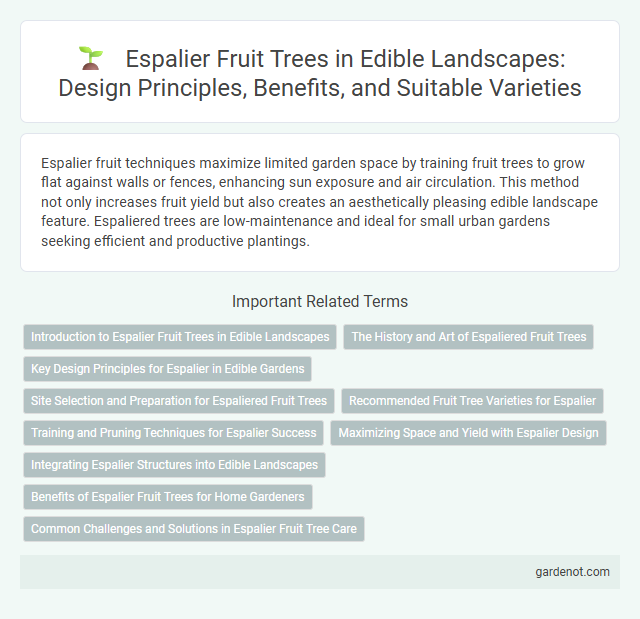Espalier fruit techniques maximize limited garden space by training fruit trees to grow flat against walls or fences, enhancing sun exposure and air circulation. This method not only increases fruit yield but also creates an aesthetically pleasing edible landscape feature. Espaliered trees are low-maintenance and ideal for small urban gardens seeking efficient and productive plantings.
Introduction to Espalier Fruit Trees in Edible Landscapes
Espalier fruit trees transform edible landscapes by training branches flat against structures, maximizing space efficiency and sunlight exposure for improved fruit production. This ancient horticultural technique enhances garden aesthetics while facilitating easier harvesting and pruning. Common choices include apple, pear, and peach varieties, which thrive in espalier form and add both beauty and bounty to small gardens.
The History and Art of Espaliered Fruit Trees
Espaliered fruit trees have been cultivated since ancient Roman times as a practical gardening technique that enhances space efficiency and fruit accessibility. This ancient horticultural art reached prominence in Renaissance Europe, where formal gardens showcased meticulously trained branches against walls, blending utility with aesthetics. Today, espalier continues to be valued for its historical significance and ability to maximize fruit production in limited spaces through precise pruning and training methods.
Key Design Principles for Espalier in Edible Gardens
Espalier fruit trees require precise pruning techniques to train branches along a flat plane, maximizing sunlight exposure and air circulation for improved fruit quality. Choosing suitable fruit tree varieties, such as apple, pear, or fig, with flexible branches enhances structural control and aesthetic appeal in edible landscapes. Proper spacing and support systems like trellises or wires ensure optimal growth while enabling efficient maintenance and harvesting in backyard edible gardens.
Site Selection and Preparation for Espaliered Fruit Trees
Choosing a well-drained site with full sun exposure is essential for espaliered fruit trees to thrive, as they require ample sunlight to maximize fruit production and maintain healthy growth. Soil preparation should involve deep tilling and incorporation of organic matter such as compost to enhance soil fertility and structure, ensuring proper root development. Installing a sturdy support system like trellises or wires before planting helps guide the tree's growth and optimizes space utilization in edible landscapes.
Recommended Fruit Tree Varieties for Espalier
Recommended fruit tree varieties for espalier include apple, pear, and cherry due to their adaptable branch structure and manageable growth habits. Dwarf and semi-dwarf rootstocks are preferred to control size and promote efficient training along walls or fences. Choosing disease-resistant cultivars like 'Granny Smith,' 'Bartlett,' or 'Stella' enhances productivity and longevity in an edible landscape.
Training and Pruning Techniques for Espalier Success
Training espalier fruit trees requires precise pruning techniques to encourage horizontal growth along a flat plane, maximizing sunlight exposure and air circulation for improved fruit production. Regularly pruning vertical shoots and side branches promotes strong scaffold arms and maintains the desired shape, preventing overcrowding and disease. Consistent, seasonal pruning during dormancy helps control tree size and directs energy towards fruiting spurs, ensuring long-term espalier success.
Maximizing Space and Yield with Espalier Design
Espalier fruit trees maximize space by training branches flat against walls or trellises, increasing sunlight exposure and air circulation. This design improves fruit yield per square foot by optimizing tree growth patterns and simplifying maintenance like pruning and harvesting. Efficient use of vertical space makes espalier ideal for small gardens and urban environments seeking high productivity.
Integrating Espalier Structures into Edible Landscapes
Espalier fruit trees create efficient use of space by training branches flat against walls or trellises, enhancing both aesthetic appeal and fruit production in edible landscapes. Incorporating espalier structures maximizes sunlight exposure and airflow, promoting healthier growth and higher yields while providing vertical green elements in small or urban gardens. This technique also facilitates easier harvesting and maintenance, making it ideal for home orchards and sustainable food gardening practices.
Benefits of Espalier Fruit Trees for Home Gardeners
Espalier fruit trees maximize limited garden space by training branches flat against walls or trellises, increasing sunlight exposure and airflow for healthier fruit production. This technique enhances fruit accessibility and simplifies pruning, harvesting, and pest management for home gardeners. Espalier trees can also serve as attractive living fences or privacy screens, combining functionality with aesthetic appeal.
Common Challenges and Solutions in Espalier Fruit Tree Care
Espalier fruit trees often face challenges such as pest infestations, fungal diseases, and improper pruning techniques that can hinder fruit production and tree health. Regular monitoring for pests like aphids and codling moths, along with timely application of organic fungicides, helps maintain tree vigor. Proper pruning, focusing on maintaining the desired shape and ensuring adequate sunlight penetration, promotes healthy growth and maximizes fruit yield in edible landscapes.
Espalier fruit Infographic

 gardenot.com
gardenot.com